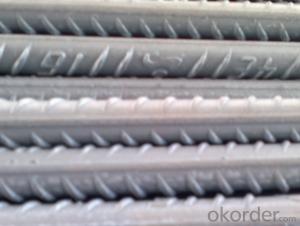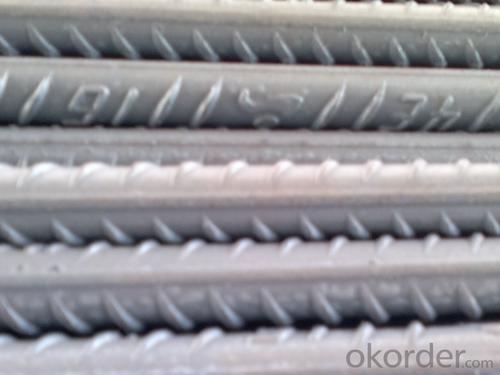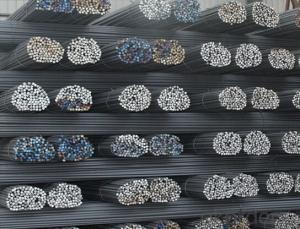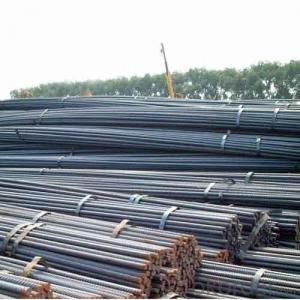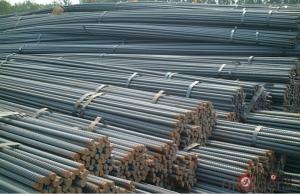Ribbed Reinforcing Deformed Steel Bar-BS4449:1997
- Loading Port:
- Tianjin
- Payment Terms:
- TT OR LC
- Min Order Qty:
- 28 m.t.
- Supply Capability:
- 30000 m.t./month
OKorder Service Pledge
OKorder Financial Service
You Might Also Like
Specifications
Ribbed Reinforcing Deformed Steel Bar-BS4449:1997
Size: from 8 to 32mm
Grade: HRB400, BIS460B, ASTMGR60,BS4449
Ribbed Reinforcing Deformed Steel Bar-BS4449:1997
Grade: HRB335 HRB400 HRB500 HPB235 ASTM A615 Gr.40 Gr.60 Gr.75 BS449B 460B 500B
SD345 SD390 SD490 SD235 SD295
Standard: ASTM JIS GB DIN
Diameter: 8mm-32mm
Length: 6m 9m 12m
Application: construction material, building material
Port of Loading: Tianjin
Delivery Time: 25 days after confirmng your order
Packing: in bundles
Ribbed Reinforcing Deformed Steel Bar-BS4449:1997
| D | THEORETICAL WEIGHT | D | THEORETICAL WEIGHT | D | THEORETICAL WEIGHT |
| /mm | (kg/m) | /mm | (kg/m) | /mm | (kg/m) |
| 8 | 0.395 | 18 | 2 | 32 | 6.31 |
| 10 | 0.617 | 20 | 2.47 | 36 | 7.99 |
| 12 | 0.888 | 22 | 2.98 | 40 | 9.87 |
| 14 | 1.21 | 25 | 3.85 | 50 | 15.42 |
| 16 | 1.58 | 28 | 4.83 |
Ribbed Reinforcing Deformed Steel Bar-BS4449:1997
| Grade | Technical data of the original chemical composition(%) | |||||
| C | Mn | Si | S | P | B | |
| HRB335 | ≤0.25 | ≤1.60 | ≤0.80 | ≤0.045 | ≤0.045 | >0.00008 |
| Physics capability | ||||||
| Yield Strength(N/cm2) | Tensile Strength(N/cm2) | Elongation (%) | ||||
| ≥335 | ≥490 | ≥16 | ||||
Ribbed Reinforcing Deformed Steel Bar-BS4449:1997
| Grade | Technical data of the original chemical composition(%) | |||||
| C | Mn | Si | S | P | V | |
| HRB400 | ≤0.25 | ≤1.60 | ≤0.80 | ≤0.045 | ≤0.045 | >0.00008 |
| Physics capability | ||||||
| Yield Strength(N/cm2) | Tensile Strength(N/cm2) | Elongation (%) | ||||
| ≥400 | ≥570 | ≥14 | ||||
Ribbed Reinforcing Deformed Steel Bar-BS4449:1997
Grade: HRB335 HRB400 HRB500 HPB235 ASTM A615 Gr.40 Gr.60 Gr.75 BS449B 460B 500B
SD345 SD390 SD490 SD235 SD295
Standard: ASTM JIS GB DIN
Diameter: 8mm-32mm
Length: 6m 9m 12m
Application: construction material, building material
Port of Loading: Tianjin
Delivery Time: 25 days after confirmng your order
Packing: in bundles
Ribbed Reinforcing Deformed Steel Bar-BS4449:1997
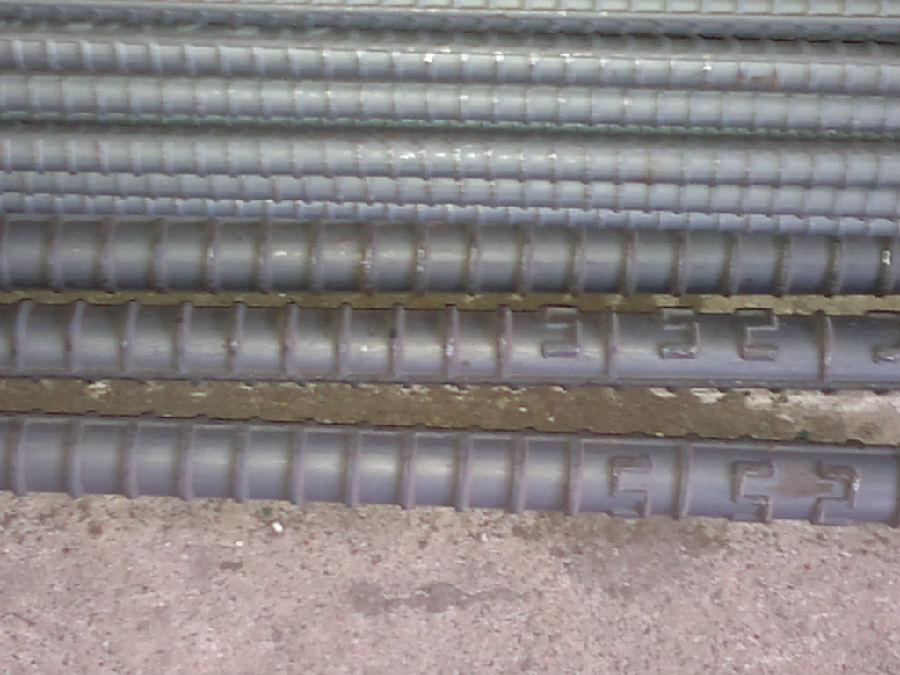


- Q: Can steel rebars be bent on-site to fit specific shapes?
- Yes, steel rebars can be bent on-site to fit specific shapes. The flexibility and malleability of steel allow it to be easily bent and shaped according to the required specifications.
- Q: Can steel rebars be used in precast or prestressed concrete?
- Yes, steel rebars can be used in precast or prestressed concrete. Steel rebars, also known as reinforcing bars, are commonly used in precast and prestressed concrete structures to provide additional strength and durability. The rebars are typically placed within the concrete matrix to withstand tensile forces that may be encountered during the service life of the structure. The use of steel rebars helps to enhance the structural integrity and load-bearing capacity of the precast or prestressed concrete components, making them capable of withstanding higher loads and minimizing the risk of failure. Additionally, steel rebars also facilitate the transfer of stresses between different parts of the precast or prestressed concrete elements, ensuring a more uniform distribution of forces and enhancing the overall performance of the structure. Therefore, steel rebars are commonly used in precast and prestressed concrete construction to improve the structural characteristics and longevity of the finished product.
- Q: Can steel rebars be used in thin concrete elements?
- Yes, steel rebars can be used in thin concrete elements. However, it is important to ensure that the rebars are properly spaced and adequately covered with concrete to provide sufficient strength and durability to the structure. Additionally, the design and placement of rebars should be carried out in accordance with the specific requirements and recommendations of the construction codes and standards.
- Q: What are the environmental benefits of using steel rebars?
- Using steel rebars in construction projects has several environmental benefits. Firstly, steel rebars are highly durable and long-lasting, which means they have a significantly longer lifespan compared to other materials. This reduces the need for frequent replacements and minimizes the amount of waste generated. Additionally, steel rebars are 100% recyclable, allowing them to be repurposed in new construction projects, reducing the demand for new materials and conserving natural resources. Furthermore, steel production emits fewer greenhouse gases compared to other materials like concrete, contributing to reduced carbon emissions and mitigating climate change. Overall, the use of steel rebars supports a more sustainable and eco-friendly approach to construction.
- Q: How do steel rebars affect the overall safety of construction projects?
- Steel rebars play a crucial role in enhancing the overall safety of construction projects. Firstly, steel rebars provide reinforcement to concrete structures, making them stronger and more resistant to various types of forces such as tension, compression, and bending. This reinforcement significantly increases the structural integrity of buildings, bridges, and other constructions, reducing the risk of collapse or failure. Moreover, steel rebars have excellent ductility, meaning they can deform without fracturing under extreme loads. This property allows rebars to absorb and distribute the energy generated during earthquakes, high winds, or heavy impacts, preventing sudden and catastrophic structural failures. Additionally, steel rebars can withstand high temperatures and fire, maintaining their strength and integrity even in the event of a fire, which is crucial for ensuring the safety of occupants. Furthermore, steel rebars are resistant to corrosion, which is a common issue in construction projects. Corrosion weakens the structure by gradually deteriorating the reinforcement. By using steel rebars, the risk of corrosion is significantly reduced, lengthening the lifespan of the construction and ensuring its long-term safety. Overall, the use of steel rebars in construction projects is vital for guaranteeing the safety and durability of structures. They enhance the strength, stability, and resistance of the building, making it capable of withstanding various external forces and potential hazards. By incorporating steel rebars into construction designs, engineers and builders can ensure that the finished project meets the required safety standards, providing peace of mind for both the construction industry professionals and the public.
- Q: What are the different methods of joining steel rebars?
- Some different methods of joining steel rebars include overlap splicing, mechanical couplers, welded splices, and threaded splices. These methods ensure a strong and reliable connection between the rebars, which is essential for reinforcing concrete structures.
- Q: What is the purpose of stirrups in steel rebar reinforcement?
- The purpose of stirrups in steel rebar reinforcement is to provide lateral support and enhance the overall structural integrity of reinforced concrete elements. Stirrups are typically made of bent steel bars that are placed around the longitudinal rebar within a concrete column, beam, or slab. One of the main functions of stirrups is to prevent the longitudinal rebar from buckling or bending due to external forces such as compression, tension, or shear. By enclosing the rebar in a series of closely spaced stirrups, the overall strength and stability of the reinforced concrete element are significantly increased. Stirrups also play a crucial role in resisting shear forces, which occur when a structure is subjected to lateral loads or earthquakes. These forces can cause the concrete to crack and fail. However, the presence of stirrups helps distribute the shear stresses more evenly, effectively preventing the formation and propagation of cracks. Furthermore, stirrups enhance the bond between the rebar and concrete by providing additional contact area. This results in improved load transfer and prevents slippage between the rebar and the surrounding concrete. In summary, the purpose of stirrups in steel rebar reinforcement is to enhance the structural strength, stability, and durability of reinforced concrete elements. They provide lateral support, resist bending and shear forces, and improve the bond between the rebar and concrete. By incorporating stirrups into the reinforcement design, engineers can ensure that the concrete structure can withstand various external loads and maintain its integrity over time.
- Q: Can steel rebars be used in heritage building restoration?
- Yes, steel rebars can be used in heritage building restoration. Steel rebars provide strength and structural support, making them an ideal choice for reinforcing deteriorated or damaged sections of heritage buildings. However, it is important to consider the specific requirements and guidelines set by heritage preservation authorities to ensure that the restoration process maintains the historical integrity of the building.
- Q: Can steel rebars be used in the construction of sound barriers and noise walls?
- Yes, steel rebars can be used in the construction of sound barriers and noise walls. Steel rebars are commonly used as reinforcement in concrete structures, which are often used to build sound barriers and noise walls. They provide strength, durability, and structural integrity to these barriers, ensuring they can effectively reduce noise pollution.
- Q: What are the guidelines for inspecting steel rebars on a construction site?
- The guidelines for inspecting steel rebars on a construction site typically include checking for proper placement, alignment, and spacing of the rebars according to the project specifications and design drawings. Inspectors also need to ensure that the rebars are free from any damages, rust, or contamination that could affect their structural integrity. Additionally, inspectors should verify the rebars' dimensions, lengths, and grades, as well as their proper anchorage and connection to adjacent elements. Regular inspections throughout the construction process are crucial to maintain quality and compliance with safety standards.
Send your message to us
Ribbed Reinforcing Deformed Steel Bar-BS4449:1997
- Loading Port:
- Tianjin
- Payment Terms:
- TT OR LC
- Min Order Qty:
- 28 m.t.
- Supply Capability:
- 30000 m.t./month
OKorder Service Pledge
OKorder Financial Service
Similar products
Hot products
Hot Searches
Related keywords
